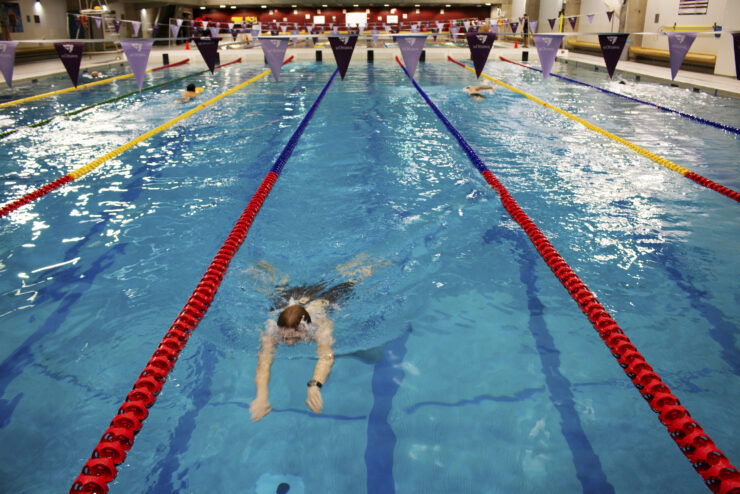The essentials for turning swimming into a workout
I know how to swim, but I’ve never used it as a serious way to get my daily exercise. How can I make it into a regular routine?
Swimming can be a fun activity, and an incredibly rewarding way to exercise year-round. Due to the flexibility of the sport, swimming gives you the option to work on virtually every muscle group, and get your heart pumping.
Plus, the University of Ottawa is one of the best places to pick it up—the Montpetit Fitness Centre hosts regular lane swims, swimming lessons, and numerous other activities in its 50-metre pool.
So if you have a basic knowledge of strokes and want to get your feet wet, this crash-course in lane swimming should give you everything you need to plan a workout routine in the water.
Understanding lane swimming culture
It may sound a little silly to think that there might be rules for swimming—but there are definitely some things you need to know.
For starters, the first thing a prospective swimmer needs to do after they’ve donned their goggles is decide on a lane. Pretty simple right? Well—not exactly.
At many pools, like the one at Montpetit, there are lanes designated for slow, medium, and fast swimmers. However, there’s no definitive swimming speed that you need to go.
Generally, the slow lane is for people wanting to get some exercise, but aren’t focused on high-levels of physical exertion. The fast lane, on the other hand, is for swimmers looking to crank-out their laps at an intense pace—so beware, if you’re not doing front crawl you may feel out of place.
The medium lane is, as the name implies, the middle ground—and, where most lane-swimming newcomers might want to start. Since swimmers decide their own pace, this lane gives you the chance to focus on your workout without holding anyone up.
In all lanes, however, you probably want to keep an eye out for the direction of travel. At the U of O pool, swimmers are supposed to swim in a counter-clockwise direction, which means that you’ll be swimming on the right-side of the lane—just as if you were in a car in North America.
Similarly, you’re allowed to swim on the left-side to pass, but be sure to look ahead before you do—or get ready for a different kind of crash-course.
Front crawl has it all
If you’re looking for a standard stroke to start your workout that incorporates your arms, upper body, and legs, then front crawl is for you.
Once you’ve stretched out your muscles and hopped in the water, try doing some slow lengths of front crawl, and focus on your breathing. Your first couple of lengths should be aimed at getting your body used to the exercise, and finding a pace that’s right for you.
As soon as you’re properly warmed up, hop on over to the fast lane, and try picking up the pace—the goal of this stroke should be to get your blood flowing a little quicker.
Breaststroke is the rest stroke
If you’re starting to feel like you need a break, but you’re not quite convinced, try doing a couple of lengths of breaststroke.
Since the stroke necessitates a glide at the end of every cycle, you can take as long or as short of a breather as you need.
Plus, once you’ve gotten back into the swing of things, breaststroke will give you the chance to really work on your chest and posterior muscles.
Drill it until you kill it
As painful as it may be to hear—drills are where the real magic happens.
While the laps you’ve been doing are undoubtedly great for your cardiovascular health, and are working different muscle groups, drills are where you can focus in on specific areas of your body.
If you’re looking to work on your arms or chest, grab a pool buoy, and head back to the medium or slow lanes.
While there are many different drills that you can try out, I’d suggest that you stick with the arm-movements for front crawl and breaststroke for the first couple of sessions. Their movement targets a variety of the muscles in your upper body, and the practice should help to improve your overall stroke technique.
The same thing can also be said for your legs. Grab a flutterboard, and take your time to focus on the muscles that you want to work on. Since swimming is a flexible sport, it’s up to you to emphasize your muscles as you try various drills.
If you enjoy swimming on your back, you can also try various kicks, and upper body workouts while staring at the ceiling—just beware of the other swimmers around you!
No matter what though, be sure to stay hydrated and have fun. You don’t need to swim like a fish, but it helps to get hooked like one!




